CHAPTER 3
Image Formats
SELECTING THE FORMAT
In the medium format, different cameras produce different image formats, so it is worthwhile to determine which format serves which purpose best.
Professionals use the medium format camera daily or at least a few times each week. Your choice of image format is important because the medium format camera is likely to become the photographic tool you use the most. When you choose a camera, price should not take precedence over the camera’s format and design characteristics.
The format decision for the camera should not even be based on the desired image shape of the final picture. For example, you should not choose a camera that shoots rectangular images simply because you or the client prefer such images over square ones. A rectangular format camera is a fine choice if it has all the features that are important in your photography, or if shooting rectangular pictures does not carry with it some inconveniences. On the other hand, shooting with a square format camera and then changing the image shape later might be a more satisfactory solution especially since the medium format negative is so large and provides excellent cropping possibilities. Rectangulars can be changed into squares, but only by sacrificing image sharpness. Squares, on the other hand, can be converted into rectangles without loss of image quality. The rectangular shape of enlarging papers should definitely never be a reason for selecting a camera that shoots rectangular images to match the paper format. Instead, give serious consideration to the following points when choosing the format of a camera:
1. the convenience of viewing and focusing and holding the camera in handheld photography;
2. the size and weight of the equipment, if you plan to use it on location;
3. the camera features; shutter, flash synchronization, available lenses, and accessories;
4. the availability and degree of interchangeability of film magazines and the emulsions that can be used;
5. the possibility of attaching a Polaroid film magazine and a magazine for electronic imaging;
6. the convenience and speed with which you can operate the camera and lenses; and
7. the availability of compatible projection equipment if slides are to be produced.
Various medium formats compared. The 2 1/4 in. square with 3020 mm2 (1), the 2 1/4 × 2 3/4 in., which is about 3850 mm2 (2); the 6 × 4.5 cm with an area of 2200 mm2 (3); the 6 × 9 cm with a 4760 mm2 area (4); and 6 × 8 cm with an area of 4370 mm2 (5). All are considerably larger than the 35 mm frame (6).
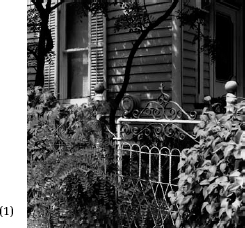
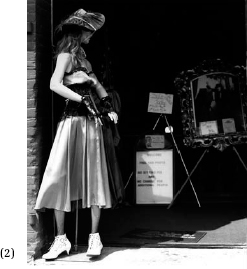

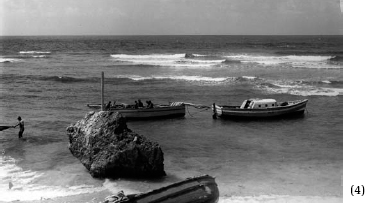
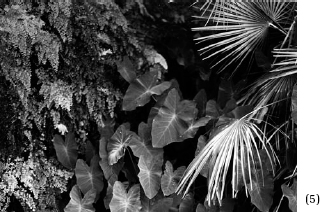
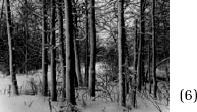
2 1/4 × 2 1/4 in. (6 × 6 cm) Square
Many photographers associate the medium format with the square, probably because the 2 1/4 in. square has been the most popular medium format in the last three decades. (It is also known under the metric measurement of 6 × 6 cm. indicating centimeters.) The actual negative size, however, is not 6 × 6 cm, but slightly less, or about 55 × 55 mm. Twelve images fit on 120 roll film, 24 on 220, and 70 or more on 70 mm perforated film, which requires a special magazine.
The 2 1/4 in. square format can be found in SLR, TLR, and wide angle medium format cameras Some cameras offer a second choice of a smaller rectangular format.
Square cameras are sometimes a second choice or are not considered at all by photographers who know that their negatives end up as rectangular prints and who do not want to waste part of the negative. It is, of course, always desirable to fill the negative so the entire area is usable in the enlargement. But changing a square into a rectangle does not mean enlarging it more than you would enlarge a rectangular negative because the degree of enlargement is determined only by the long side of the negative, not the negative area. The long side remains the same; thus the 2 1/4 in. square cropped to a rectangle has to be blown up exactly the same as the full 6 × 4.5 cm negative.
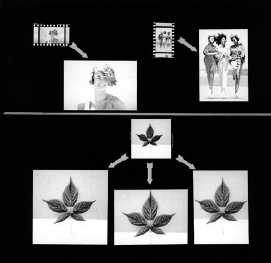
A 35 mm image produced as a horizontal most likely remains a horizontal as a print and a 35 mm vertical frame probably remains a vertical (top). An image produced as a square in the camera on the other hand may remain a square or may be presented as a horizontal or as a vertical. You, therefore, should not necessarily “think square” when working with a square format camera (bottom).
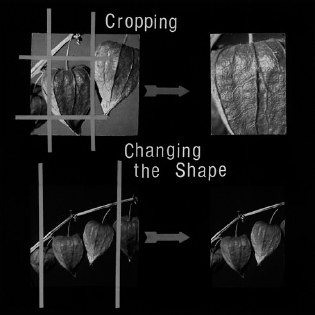
When changing a square original into a vertical or horizontal, you simply change the shape of the image. The image remains the same size and you, therefore, do not lose quality. Cropping means using a small portion of the original and enlarging the subject with a consequent loss of sharpness.
Photography with a Square Camera. The square camera is designed for the greatest operating ease and convenience, so there is no need to decide whether to hold the camera for horizontals or turn it sideways for verticals. There are also advantages when working from a tripod or working with portable flash. The camera always sits on the tripod the same way. No need to tilt the tripod head and no need to move the portable flash. It is always in the same position above the camera lens.
The real benefit of shooting square, however, is in viewing. A camera that needs to be turned for verticals must be equipped with a 90 prism finder, since such a finder is the only practical viewing method when the camera is turned. Such a camera thus becomes an eye-level camera that must always be held in front of your eyes. The square format camera, on the other hand, can be equipped with eye-level finders—a 45° prism finder—or a waist-level type for viewing directly from the top. The square format camera gives you much more freedom, allowing you to photograph from practically any angle easily. The benefits of not having to turn the camera can also be obtained with a 6 × 7 camera with a rotatable film magazine, but only by compromising on size and weight.
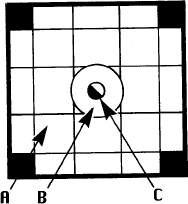
The guidelines on so called checked screens may correspond to the rectangular paper proportions. The framing area becomes more obvious by darkening the four corners with translucent tape or colored foil. If the screen has a microprism and/or split image rangefinder, the image can be focused either on the screen (A), the microprism (B), or with the rangefinder (C).
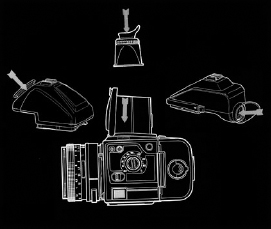
Since a square format camera never needs to be turned, you have the option of viewing the focusing screen image from eye level with a 90-degree eye-level finder, with a 45-degree prism viewfinder or from above the camera with a folding type focusing hood or a magnifying hood.
Square Prints. Instead of changing square negatives into rectangular prints, why not crop the rectangular paper to make square prints? The final print format must be a personal decision, but square prints can be very effective for just about any purpose, as are square transparencies in projection.
Square prints make for attractive wedding or display albums. Every print fits the square album page with an even border, looking like a framed picture. Twelve square images can be contact proofed on one sheet of 8 × 10 in. paper. All images are right side up, so viewers need not turn the sheet.
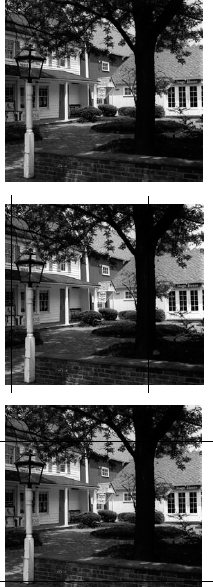
Square images provide a lot of freedom in cropping. Subjects can be composed to make good squares (top), verticals (middle), or horizontals (bottom).
Square slides make an effective slide presentation, with each image taking up the same space and filling the full area of a square projection screen. Audiovisual professionals believe that a presentation with square images is more effective than switching between verticals and horizontals. Slide mounts for 2 1/4 in. square images are readily available.
Since many images from professional photographers are used in a rectangular version, especially when they are used on covers of magazines, photographers often like to submit to the client or art directors images in the rectangular, usually vertical format. By submitting rectangular images, photographers may prevent or reduce other cropping choices the art director may have in mind. The methods for producing rectangles in square format cameras are discussed under the heading “6 × 4.5 in the Square Format Camera.”
The 6 × 4.5 cm Format
The true negative size of the 6 × 4.5 cm format is about 40 × 55 mm. Some medium format cameras are made specifically and only for this format. On others, you can choose this format by attaching a separate magazine, thus you have the choice of shooting squares or rectangles. The 6 × 4.5 cm negative has an aspect ratio that is almost identical to 8 × 10 in. and 16 × 20 in. paper; thus the full negative can be printed. The degree of enlarging you need to do when making a rectangular print is the same for the 6 × 4.5 cm format as for a 2 1/4 in. square cropped along one or two sides. Consequently, there is no benefit to using the 6 × 4.5 cm format as far as image quality is concerned.
The benefit of the 6 × 4.5 cm format is in the larger number of exposures per roll of film. Sixteen 6 × 4.5 cm. images fit on the same film length as twelve 2 1/4 in. squares if the images are equally and properly spaced. This is not the case on some 6 × 4.5 cm cameras where manufacturers have cut production costs by eliminating the rather complicated mechanism that provides even frame spacing on the unperforated roll films. As a result, such cameras only give 15 exposures on a roll of 120 film. The three or four additional exposures per roll in the 6 × 4.5 format are a benefit. The film costs are 20 to 30 percent lower. All 6 × 4.5 cm format cameras must be turned for verticals, so viewing becomes limited to the 90° eye-level finder. This limitation must be considered carefully.
The 6 × 4.5 cm format is frequently referred to as the ideal format, but that does not necessarily mean that it is ideal for photography. It simply means that the format has the same aspect ratio as the 8 × 10 in. enlarging paper. Whether the format or the 6 × 4.5 cm camera is ideal is up to each individual photographer.
The 6 × 4.5 cm in the Square Format Camera
Square format cameras with interchangeable film magazines usually can be equipped with a film magazine for the 6 × 4.5 cm format. Depending on the manufacturer, such a magazine produces 15 or 16 images on a roll of 120 film, twice as many on 220 roll film. Horizontals can be obtained in the normal camera position; for verticals the camera needs to be turned.
To make it still easier for the square shooting pro to produce rectangulars, some manufacturers now have available masks that can be inserted into the back of square cameras. They give the photographer the option of producing squares, horizontals, or verticals. You receive the same number of exposures in all formats—12 on 120 and 24 on 220 film—but you need not turn the camera. You simply turn the mask. Using the mask also produces the proper image format on the Polaroid test shot, which is helpful when the test shot is presented to the client or art director for final approval while shooting.
The 40 × 40 mm Format
The 40 × 40 mm format, known as superslide, used to be fairly popular because the images it produces could be projected in a standard 35 mm slide projector. Special superslide film magazines were available for some cameras. But this format has been discontinued because most modern 35 mm projectors no longer project these larger slides with proper corner to corner quality and illumination.
To produce superslides today, make the images in a 6 × 4.5 mm film magazine, then cut the long side to produce a square.
The 6 × 7 cm (2 1/4 × 2 3/4) Format
This largest of the more popular medium formats also has an aspect ratio that closely resembles that of the popular enlarging papers. The actual negative size, about 56 × 68 mm, makes the image visually very effective and large compared to the smaller formats. However, you must first consider that only 10 negatives fit on one roll of 120 film—two fewer than 2 1/4 in. squares, and five or six fewer than in the 6 × 4.5 cm format. The film cost is thus 20 to 60 percent higher, and you will need to change film more often. More important are the size and weight of the camera. This larger negative can be obtained only on cameras specifically made for this format, which consequently have to be larger and heavier.
On some 6 × 7 cm cameras horizontal and vertical images are obtained by turning the camera; on others this is done with a rotatable film magazine that also changes the format aspect on the focusing screen.
The 6 × 7 cm format is not practical for contact proof printing because only 9 of the 10 images from a 120 roll film will fit on an 8 × 10 in. sheet of paper. This is a relatively unimportant consideration since most 6 × 7 cm photographers do not contact print their negatives but have individual proofs made instead.
The full 6 × 7 cm format shot can be projected only in a special slide projector. Other possibilities are to cut the rectangle down to a 2 1/4 in. square or a 6 × 4.5 cm rectangle for use in 2 1/4 in. slide projectors.
The 6 × 8 cm Format
The 6 × 8 cm medium format first appeared in 1986. It is presently available from only one camera company that promotes it as the format that provides the most effective vertical/horizontal ratio. The image size is 56 × 76 mm. Considering the 8 × 10 in. paper proportions as standard, the 6 × 8 cm format needs some cropping at the long side. You obtain nine exposures on 120, 18 on 220 film. The nine exposures can be contact printed on an 8 × 10 in. proofsheet.
COMPARING FORMATS
All the formats discussed up to this point are good choices for any type of medium format photography in the studio and on location. Image format, therefore, should not completely or mainly influence your choice of camera. You are more likely to make a wise choice by carefully considering the camera operation and handling, its features as they relate to your type of work, the reputation of the manufacturers, and especially camera size and weight.
If all your work is done on a tripod in the studio, size and weight need not be a factor. To me, however, a medium format camera was never meant to be a studio camera. Referred to as the “camera in the middle,” it is supposed to be a camera that is great for critical studio work and equally well suited for location photography, handheld if desired or necessary. That is exactly how most professionals use a medium format camera. Amateurs do even less work indoors, using their cameras mainly during their travels and for nature work. This is why I feel that choosing a medium format camera system has everything to do with size. Not just the size of the image, but also the size and weight of the camera. To get an image in the 6 × 7 cm format that is only one centimeter longer (approximately 20 percent), than the 2 1/4 square or an image in the 6 × 4.5 cm size, you may have to carry a camera that weighs as much as 80 percent more.
Consider the matter of camera size and weight very carefully if you’re looking for one medium format system that can do it all. A light, compact camera will handle your most critical studio work, yet hand-held on location, it can be as much of a pleasure to use as a 35 mm camera.
One of the greatest benefits of the medium format is that it is a great format for any type of photography. A good compact, lightweight medium format camera system can serve all purposes in the studio and on location (for example, studio portraiture and candid wedding work) and eliminate the need for owning and operating two different systems.
When comparing different formats, it is also essential that we differentiate between the film area and image size. Film area is important in visual observation of a negative or transparency on a lightbox or in the size of a projected image. For these purposes, it is proper to call an image twice as large when the area is twice the size. Area, on the other hand, cannot be used to compare image size or necessary degree of enlargement. The length of the negative side must be used for this comparison. For example, the 6 × 7 cm film area is about 60 percent larger than 6 × 4.5 cm, but the difference in image size or degree of enlargement is only about 20 percent.
In a full-length portrait, for example, the model is only about 20 percent larger on 6 × 7 cm compared to either the 2 1/4 in. square or the 6 × 4.5 cm format. The larger image made retouching the original 6 × 7 cm negative or transparency somewhat easier. This is however no longer a factor today since most retouching is done digitally. The same is true of the degree of enlargement. The 6 × 4.5 cm negative, or the 2 1/4 in. square cropped down to the 8 × 10 in. paper proportion, must be enlarged only 20 percent more than the full 6 × 7 format image to obtain the same size enlargement.
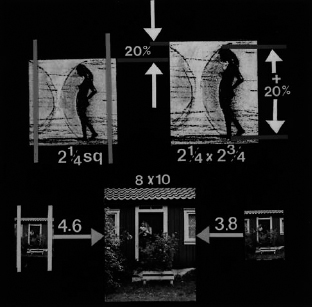
The film area of a 6 × 7 cm negative (right) is about 60 percent larger than the 6 × 4.5 cm area out of a 2 1/4 in. square (left), but the size of the subject recorded on the 6 × 7 cm image is only about 20 percent larger. Image size is determined by the long side of the negative, which is 20 percent (68 mm versus 56 mm). The difference in the degree of enlargement is also only 20 percent.
IMAGE SHARPNESS
Assuming that everything else in the camera such as the performance of the lens, the film flatness, the accuracy in the mirror and screen alignment are equal, the 6 × 7 cm image should be about 20 percent sharper; or to say it in a different way, the larger negative should allow for a 20 percent higher blowup of the image while retaining equal image quality. This, however, has not proven to be the case. Film tests made by photographic magazines and photographers seem to indicate that the 6 × 7 cm format yields images that are not noticeably better or not at all sharper compared to a good 6 × 4.5 cm image cropped from a 2 1/4 in. square. Therefore, better image sharpness should not be a reason for selecting the larger format.
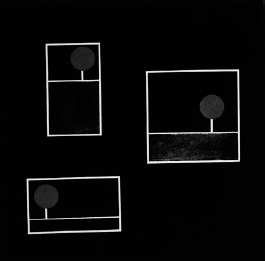
The same suggestions for good composition, such as placing main lines and main subjects approximately one third from left or right and one third from top or bottom, apply in squares as well as in rectangles.
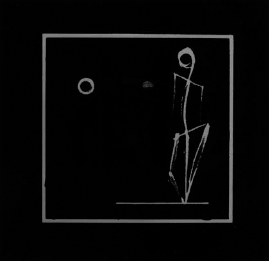
Main subjects placed to one side of the image require a balance on the other side in any image format.
OTHER MEDIUM FORMATS
The 6 × 9 cm Format
One of the original popular medium formats has not disappeared. The 6 × 9 cm (2 1/4 × 3 1/4 in.) format producing eight images on a roll of 120 film is still here, but only in press and aerial cameras, in rangefinder and wide angle types, and is used in special roll film magazines for view and press cameras.
Since standard roll film is used in most 6 × 9 format cameras, the same wide choice of film available for the more popular medium formats is also available for this format.
The 6 × 9 cm format has the same 2 × 3 proportions as the 35 mm image. Neither matches the 8 × 10 in. paper proportions. The long side must be cut.
Panoramic Formats
Although the usable width of roll film limits one side of the image to 56 mm, the other side of the image can be stretched along the film as far as the lens is capable of covering. That is what is done in panoramic cameras where the format ranges from 6 × 12 cm (six images on a roll of 120 film) to a format that is almost three times longer than it is wide: 6 × 17 cm (2 1/4 × 6 3/4 in.) with four images per roll of 120 and eight on 220. The film area of the latter is equivalent to three 2 1/4 × 2 1/4 in. images.
The panoramic formats may mainly serve to capture an area wider than is possible with a wide angle lens on an ordinary format, but also offer a new way of creating visually dramatic images with excellent overall quality.
Panoramic images also have a lifelike appearance; they are closest to the way we see. Panoramic cameras can take into one picture the wide horizontal sweep that we can see with our eyes from the top of a mountain or building, a lakeshore, beach, or city street. Since normal viewing is horizontal, these cameras are most often used for horizontals. The camera can be used for verticals and can be excellent for enhancing the height of a waterfall, tall trees, or buildings.
Panoramic medium format cameras need to be larger, but still can be used in handheld camera work. They are usually equipped with a spirit level to ensure straight horizontals or verticals. The film gate and pressure plate in such cameras must be designed to keep the large negative area flat from one side to the other.
Negatives from panoramic cameras cannot be enlarged in an enlarger that is equipped for the typical medium formats. The 6 × 12 cm negative requires an enlarger made for 4 × 5 in., and a 5 × 7 in. type is needed for the even larger 6 × 17 cm negative.
Masks are available for some medium format cameras to produce panoramic images within the 2 1/4 × 2 1/4 in. image area. There is not much benefit in using such a mask however if the film is advanced in the normal fashion. You do not obtain more images on a roll of film so you might as well take them in the 2 1/4 square or 6 × 4.5 cm format and cut them into panoramas afterwards. You might be able to produce 22 to 24 panoramic images on a roll of 120 film, however, by using the camera’s winding crank only to recock the shutter and advancing the film with the winding crank on the film magazine.
Panoramic photography has become popular with the introduction of the Hasselblad XPan camera, which has the size and weight of a 35 mm camera. While this camera uses 35 mm film, the image format with the long side of 65 mm (24 × 65 mm) can be considered a medium format, and the camera’s lenses are designed to cover the 6 × 4.5 cm image format.
35 MM IN THE MEDIUM FORMAT CAMERA
The combining of medium format photography and 35 mm film has been made possible by some manufacturers who supply a 35 mm film magazine for medium format cameras. This innovation was never meant to encourage the use of 35 mm film in a medium format camera. Most photographers are better off using a good 35 mm system when 35 mm is needed.
The idea for a 35 mm magazine goes back to the time when Kodachrome film was available only for 35 mm, and some photographers or art directors insisted on this type of film. With the great choice of superb color transparency films available today, this application has lost its value at least for producing images in the standard 24 × 36 mm size. Some manufacturers, however, have a 35 mm magazine for producing panoramic images on 35 mm film in a medium format camera.
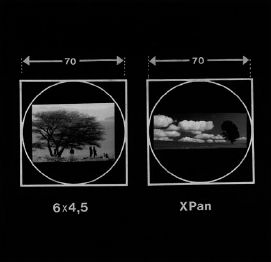
While produced on 35 mm film, the 24 × 65 mm image of the XPan camera can be considered a medium format as its image diagonal is equal to that of the 6 4.5 cm medium format.
